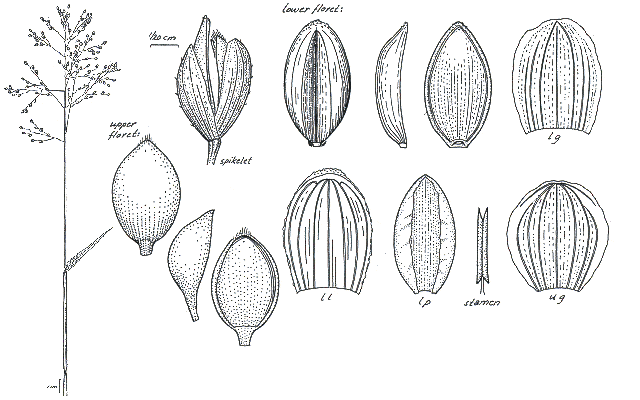Isachne globosa (Thunb.) Kuntze. Rev.
Gen. Pl. 2: 778 (1891).
Classification. (GPWG 2001) : Subfamily
Micrairoideae. Isachneae.
Basionym and/or
Replacement Name: Milium globosum
Thunb. ex Murray, Syst. Veg., 109 (1784).
Type of Basionym or
Protologue Information: Japan: without specific locality, Thunberg 2041
(HT: UPS).
Recent synonyms:
I. australis.
Key references
(books and floras): [1810]. R.Brown, Prodromus (196 as Isachne
australis), [1878] G.Bentham, Flora Australiensis 7 (625 as Isachne
australis), [1969] E.E.Henty, Manual Grasses New Guinea
(114), [2002] D.Sharp & B.K.Simon, AusGrass, Grasses of Australia,
[2006] J.Jessop, G.R.M.Dashorst, F.M.James, Grasses of South Australia
(507), [2008] S.W.L.Jacobs, R.D.B.Walley & D.J.B.Wheeler, Grasses of New
South Wales (284).
Illustrations:
[2006] J.Jessop, G.R.M.Dashorst, F.M.James, Grasses of South Australia (508, fig. 436 & plate 19), [1984] N.T.Burbidge.
rev. S.W.L.Jacobs, Australian Grasses (163).
Habit. Annual
or perennial. Culms erect or geniculately ascending or decumbent or prostrate,
10–90 cm tall. Leaf-sheaths glabrous on surface or hairy. Ligule a fringe of
hairs, 1–4 mm long. Leaf-blades linear or lanceolate or ovate, 1–14 cm long,
3–20 mm wide.
Inflorescence.
Inflorescence compound, a panicle. Panicle ovate, 1–15 cm long, 1–8 cm wide.
Spikelets.
Spikelets pedicelled. Fertile spikelets 2-flowered, the lower floret barren
(rarely male), the upper fertile, comprising 1 basal sterile florets,
comprising 1 fertile floret(s), without rachilla extension, orbicular, terete
or dorsally compressed, 1.5–2.4 mm long.
Glumes.
Glumes similar, thinner than fertile lemma. Lower glume elliptic to orbicular,
membranous, without keels, 5–7 -nerved. Lower glume surface glabrous or
indumented. Upper glume oblong or ovate, 1–2.1 mm long, membranous, without
keels, 7–9 -nerved. Upper glume surface glabrous or indumented. Florets.
Basal sterile florets 1, male, with palea. Lemma of lower sterile floret 100 %
of length of spikelet, chartaceous or cartilaginous, 5 -nerved. Fertile florets
bisexual or female.
Fertile
lemma 1–1.8 mm long, without keel, 5–7 -nerved. Lemma surface glabrous or
indumented. Palea 2 -nerved. Anthers 3.
Continental
Distribution: Temperate Asia, Tropical Asia, Australasia, and Pacific.
Australian
Distribution: Northern Territory, South Australia, Queensland, New South
Wales, Victoria.
Northern Territory:
Darwin & Gulf. South Australia: Murray, Southern Lofty. Queensland:
Cook, Darling Downs, Moreton, North Kennedy, Wide Bay, South Kennedy, Port
Curtis. New South Wales: North Coast, Central Coast, South Coast,
Northern Tablelands, Central Tablelands, South-Western Slopes. Victoria:
East Gippsland, Eastern Highlands, Gippsland Plain, Grampians, Midlands, Otway
Plain, Riverina, Wannon.
Notes.
Diagnostic features include leaf length and shape, and the cartilaginous lower
floret. Anatomically there appears to be a split between the northerly and
southerly specimens. Those from Qld. and NT are broader and abaxially flat in
transverse section; prickles are usually only present on the intercostal zones
of the abaxial epidermis.
Native. Native to
India, tropical Asia and in Australia. In tropical and subtropical wet
sclerophyll forests, temperate wet sclerophyll forests, dry sclerophyll
forests, tropical and subtropical sub-humid woodlands, temperate sub-humid woodlands,
and coastal grasslands. In Australia from the topics to the temperate regions.
Regarded as a good fodder species. Flowers throughout the year.










